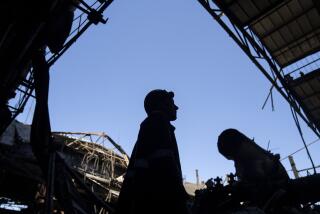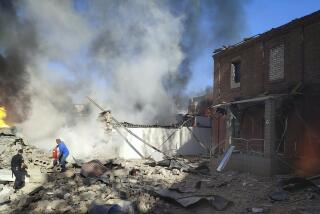Plant Safety Gains Seen as Too Slow : Eastern Europe: Western experts plod ahead but concede that danger remains severe.
- Share via
WASHINGTON — Western nuclear safety experts are concentrating on programs to improve the operating procedures, training and management techniques that they hope will prevent or at least delay catastrophic accidents at the dangerously antiquated atomic power stations stretched across Eastern Europe in the wreckage of communism.
But progress has been painfully slow, and U.S. officials concede that the danger remains severe that there will be many more incidents like Tuesday’s leak of radioactive gases from a Russian power plant near St. Petersburg.
“The United States has recognized the severity of nuclear reactor safety problems in the former Soviet Union for several years and has been cooperating both bilaterally and through international organizations in an effort to help reduce those problems and avoid future Chernobyls,” State Department spokeswoman Margaret Tutwiler said Tuesday in response to criticism that the West had failed to take decisive action.
Washington’s first-line effort is a 2-year-old cooperative venture to patch up the operation of nuclear plants in the former Soviet Union. But this initiative has been slowed by the political turmoil that accompanied the union’s demise.
U.S. and Soviet experts met in Washington last Dec. 19 to make plans for the joint management, training and maintenance effort. Less than a week later, the Soviet Union ceased to exist. Although President Boris N. Yeltsin’s Russia plans to continue the program, there have been no more talks.
In addition to the United States, Western European nations have offered similar technical assistance. The International Atomic Energy Agency has conducted a series of safety inspections of reactors in Russia, other nations of the new Commonwealth of Independent States, Lithuania, Bulgaria and other Eastern European countries.
Across Eastern Europe and the republics of the former Soviet Union, more than two dozen nuclear power reactors are operating without containment vessels, redundant safety equipment and the detailed emergency plans that are required in the West.
In Russia and the neighboring Commonwealth republics alone, there are 16 RBMK-type reactors. That was the type of reactor that leaked radiation near St. Petersburg this week and, more alarmingly, was involved in the explosion and fire at the Chernobyl plant in Ukraine that spread radiation across much of Europe in 1986.
In the West, such plants would be shut down at once. But in the fragile economies of Eastern Europe, this seems impossible.
Assistant Energy Secretary William H. Young, director of Washington’s program to assist nuclear plant managers in the former Soviet Union, conceded that it is impractical to consider closing down the dangerous plants.
“Therefore, we have focused in the joint initiative on possible improvements in operating practices as the most effective, practical, short-term way to enhance nuclear power plant safety,” Young said after the December meeting in Washington. “Initially, we are concentrating on procedures and practices to maintain control during emergencies.”
However, Paul Goble, a former State Department expert on Soviet republics who quit over policy, said that Western response has been “pretty minimal.”
In a telephone interview Wednesday, Goble said that the U.S.-Soviet joint venture is “pretty much a dead letter because there has been so much chaos.”
Goble called on the West to rethink the conventional wisdom that the plants will have to continue running indefinitely.
More to Read
Sign up for Essential California
The most important California stories and recommendations in your inbox every morning.
You may occasionally receive promotional content from the Los Angeles Times.













